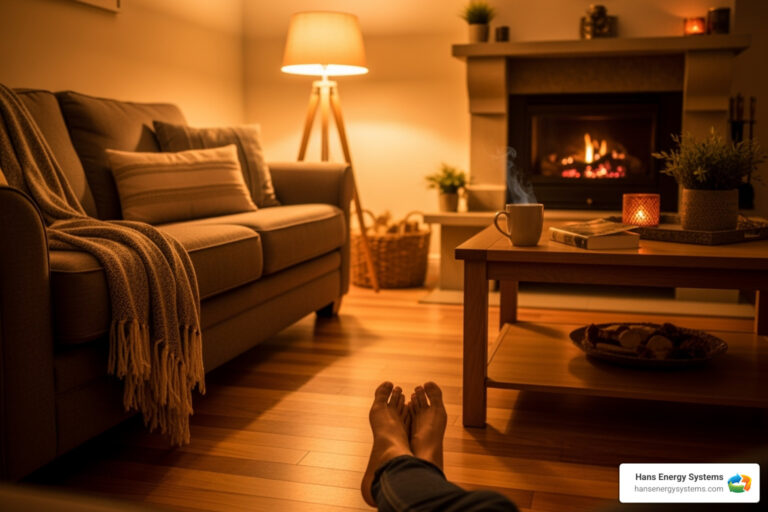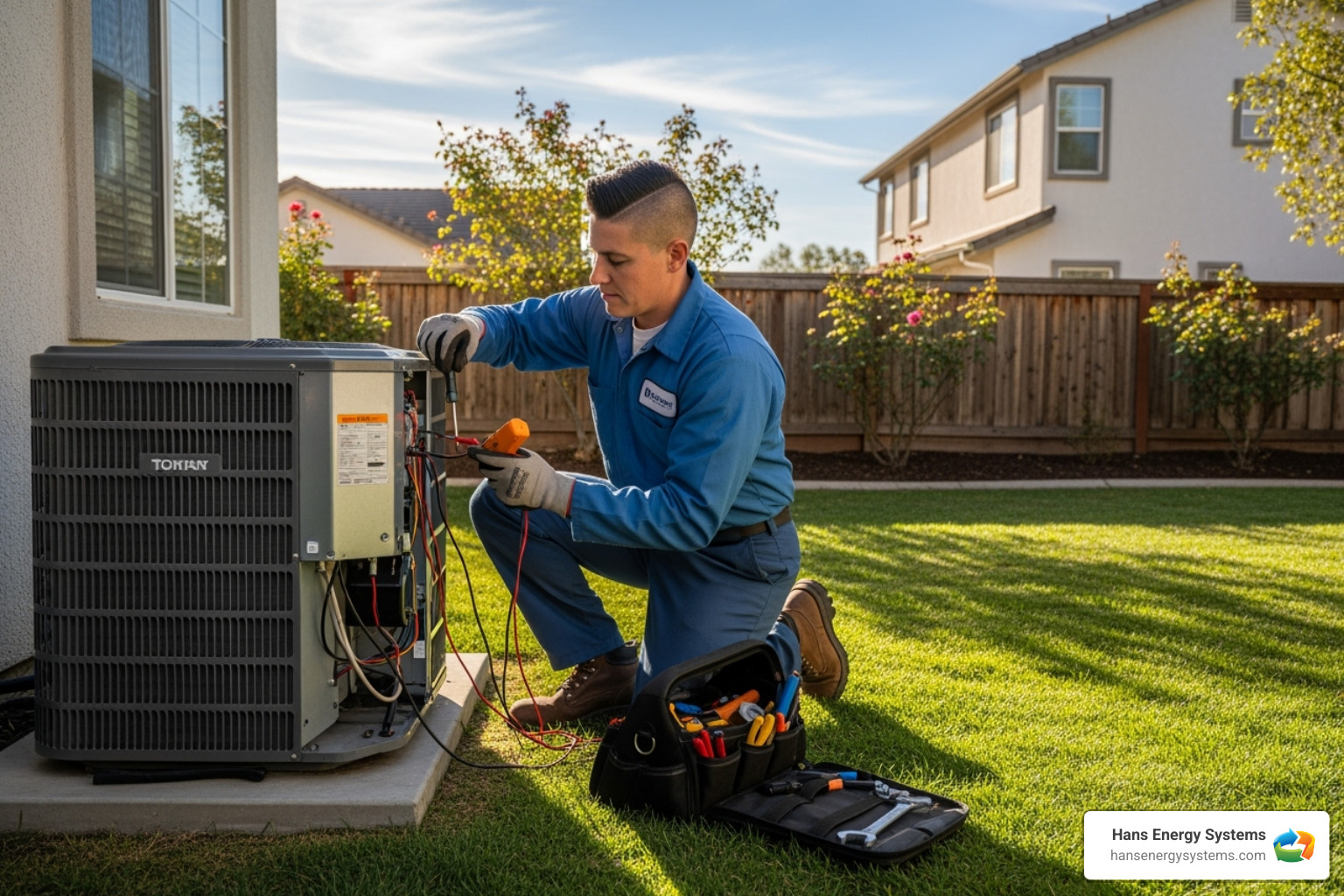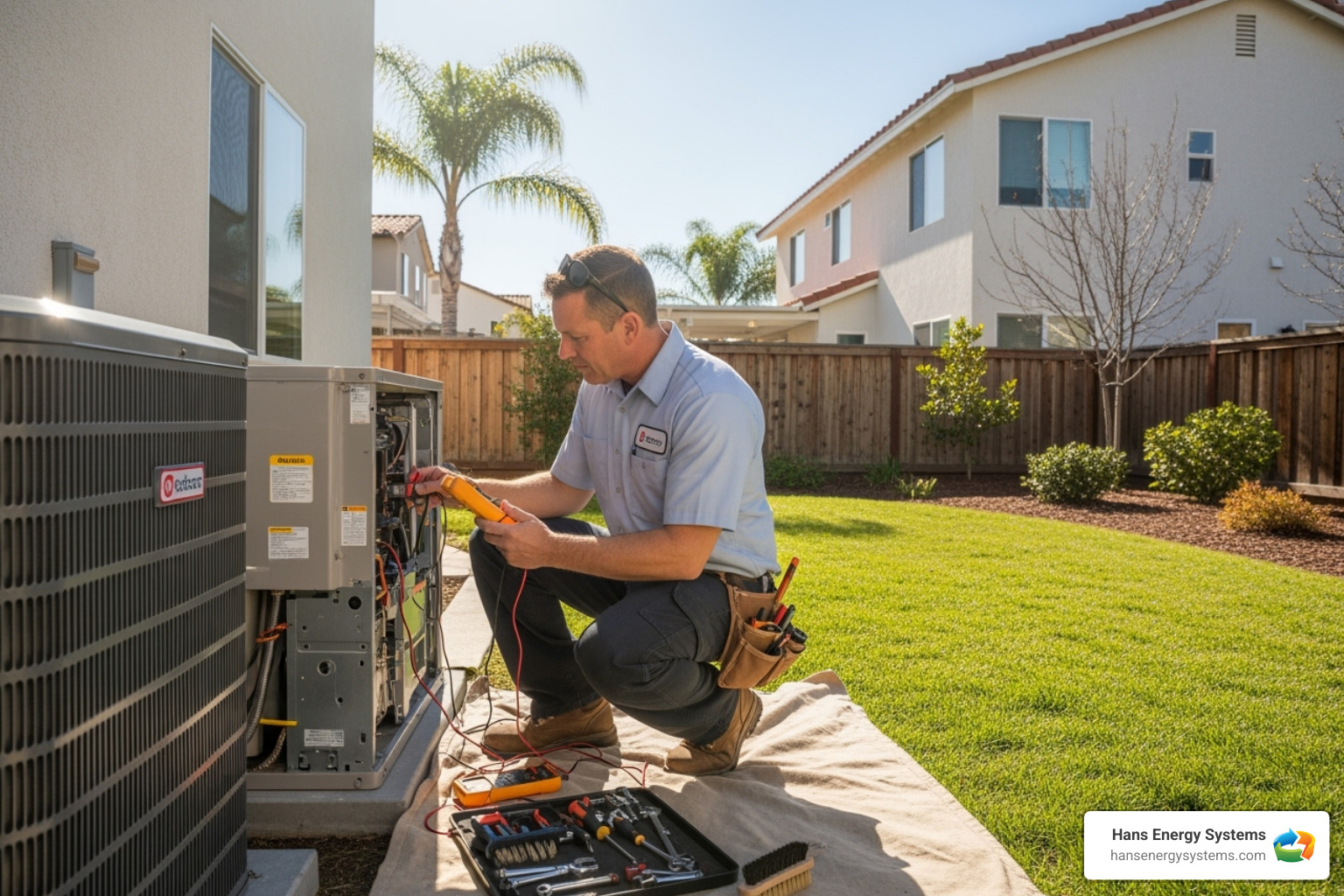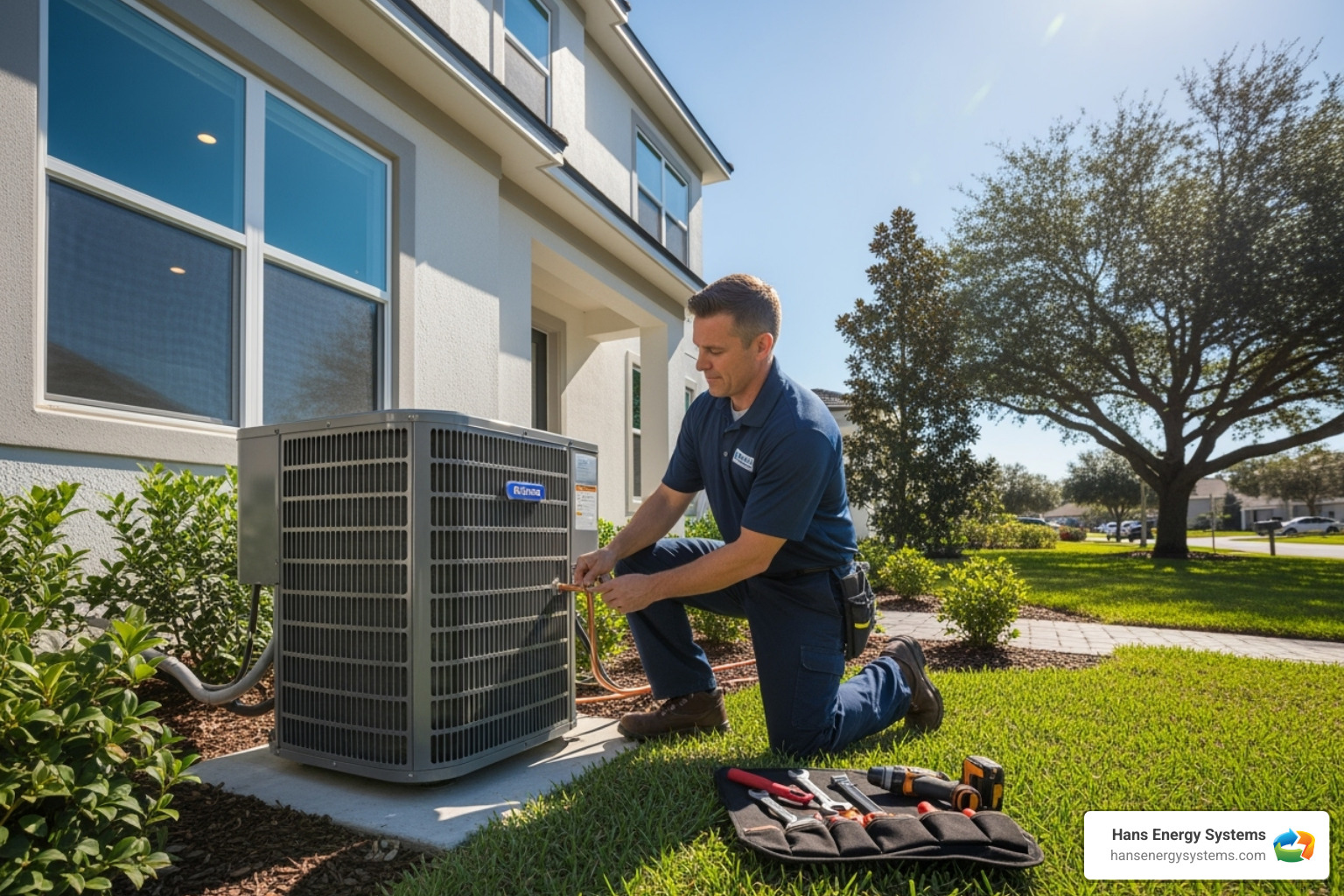Why Radiant Heating Systems Are Revolutionizing Home Comfort
Radiant heating systems supply heat directly to your floors, walls, or ceilings, warming objects and people through infrared radiation rather than just heating the air like traditional forced-air systems.
Key Types of Radiant Heating Systems:
- Hydronic Systems – Use hot water circulated through PEX tubing (most efficient for whole-home heating)
- Electric Systems – Use electric cables or mats under flooring (ideal for smaller areas or bathrooms)
- Radiant Panels – Wall or ceiling-mounted units for supplemental heating
Main Benefits:
- 20-30% more energy efficient than forced-air systems
- Silent operation with no noisy fans or blowers
- Even heat distribution without hot and cold spots
- Improved air quality (no dust circulation)
- Compatible with any flooring type
Tired of stepping on cold floors during chilly San Diego mornings? You’re not alone.
Unlike traditional heating that creates drafts, radiant heat works like sunshine, warming objects directly to create an unparalleled sense of comfort with steady, consistent warmth from the ground up.
While the technology dates back to the ancient Romans, modern radiant heating has evolved into one of the most efficient and comfortable ways to heat your Southern California home.
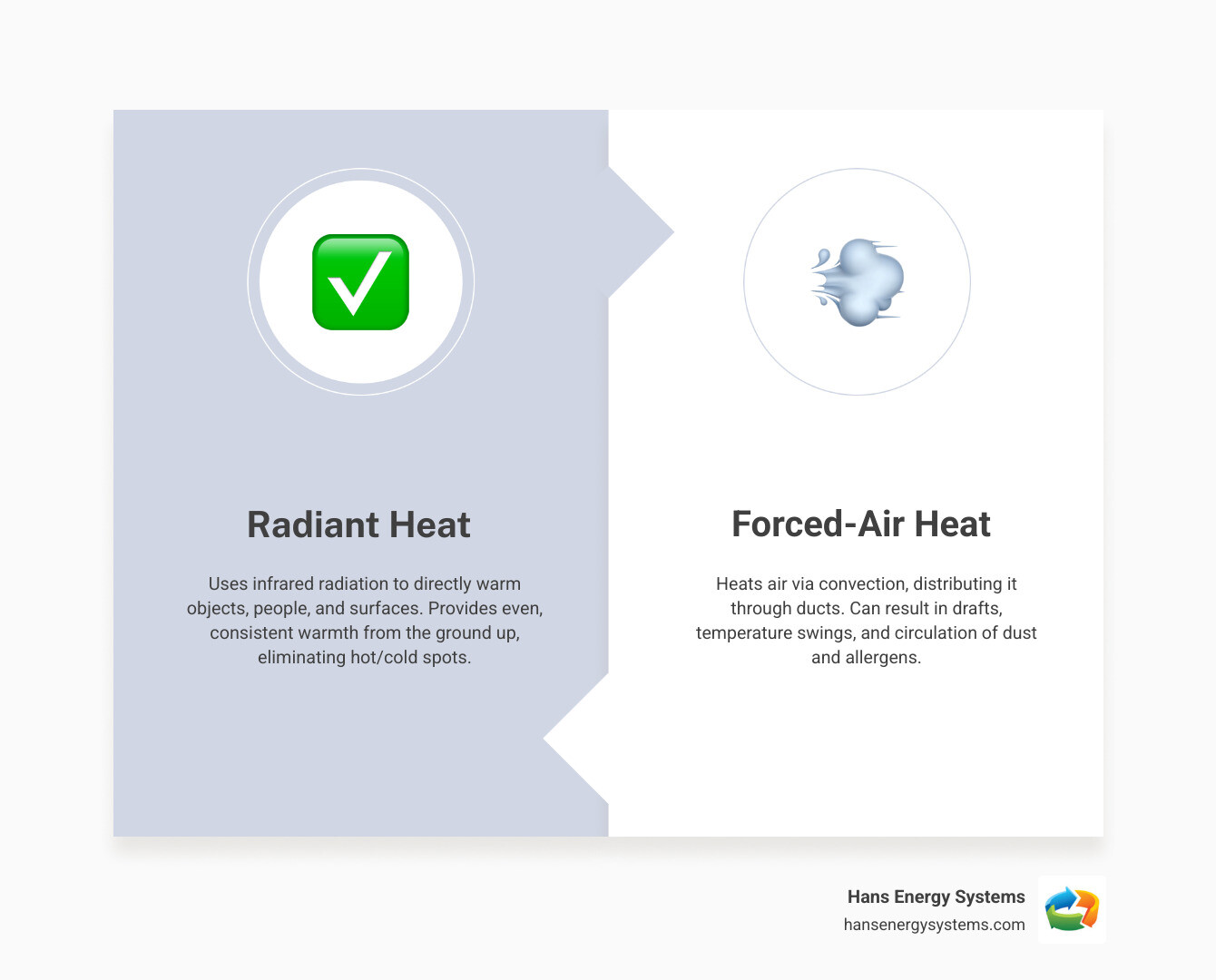
How Radiant Heating Works: The Science of Comfort
The comfort of radiant heating systems comes from infrared radiation—the same principle that makes a campfire feel so cozy even in chilly air.
Unlike forced-air systems that heat the air, radiant heat works like sunshine, warming objects and people directly with gentle infrared waves. This creates an enveloping comfort from the ground up that you, your family, and even your pets will appreciate.
This method of heat transfer is key. Traditional systems use convection, blowing hot air that creates annoying hot and cold spots. Radiation, however, spreads heat evenly throughout your space for consistent comfort.
Because heat starts at the floor and radiates upward, you get even heat distribution that eliminates chilly corners and drafts, blanketing your living space in warmth.
The U.S. Dept of Energy Guide to Radiant Heating explains how this natural heating method can be up to 30% more efficient than conventional systems. The science is simple, but the comfort is extraordinary.
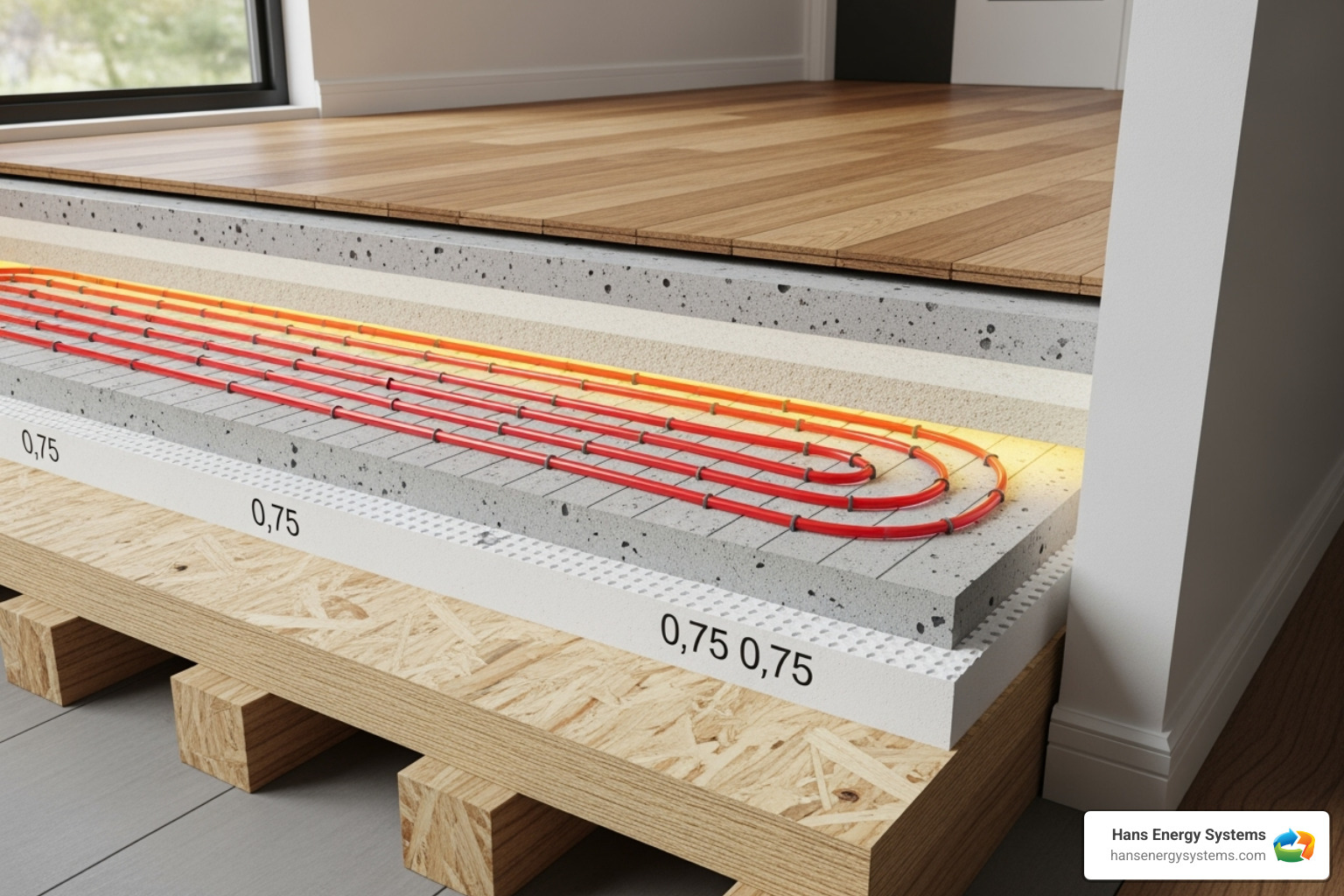
Hydronic vs. Electric Systems
When upgrading to radiant heating systems, you’ll choose between two main types, each designed for different needs.
Hydronic systems are the workhorses of whole-home heating. These systems pump hot water through flexible PEX tubing installed beneath your floors. A boiler heats the water, which then travels through the tubes like a warm river flowing under your feet.
Hydronic systems are incredibly efficient with lower operating costs. They can connect to various fuel sources, including heat pumps. Because water retains heat so well, they are perfect for larger homes needing consistent warmth.
Electric systems take a different approach. Instead of water, they use electric cables or pre-made electric mats that generate heat when electricity flows through them. These systems warm up faster and are much easier to install, especially in smaller spaces like bathrooms or kitchens.
| Feature | Hydronic Systems | Electric Systems |
|---|---|---|
| Cost | Higher upfront, lower operating costs | Lower upfront, higher operating costs |
| Efficiency | Excellent for whole homes | Great for smaller areas |
| Installation | Complex, best for new construction | Simple, perfect for renovations |
| Best Use Cases | Whole-house heating, large spaces | Bathrooms, small rooms, spot heating |
Key System Components
Every radiant heating system needs several key components working together to deliver comfort to your home.
The heat source is your system’s engine. For hydronic systems, this is typically a high-efficiency boiler. Modern homes increasingly use heat pumps as their heat source because they’re incredibly efficient and can provide both heating and cooling. If you’re curious about heat pump options, our heat pump services can help you explore this versatile technology.
PEX tubing is the highway system for hydronic heating. These flexible, durable tubes snake through your floors, carrying heated water to every corner of your home. PEX resists corrosion and can handle high temperatures for decades.
Manifolds act like traffic controllers, directing heated water from the main line into individual loops that serve different rooms or zones. This ensures every area gets the right amount of warmth.
For electric systems, electric cables replace the PEX tubing. These thin, flexible wires generate heat directly and can be installed in thin mats for easy installation.
Thermostats and control systems give you the power to customize your comfort. Modern systems let you set different temperatures for different rooms. These smart controls monitor temperatures and adjust heating automatically, keeping you comfortable while saving energy.
The Ultimate Guide to Radiant Heating Systems: Pros and Cons
Imagine waking on a chilly San Diego morning and stepping onto floors that greet your feet with gentle warmth. No shocking cold tiles or waiting for the heat to kick in—just instant comfort.
This is the reality for homeowners with radiant heating systems. But like any home improvement, it comes with benefits and considerations to understand before you invest.
Radiant heat transforms your home by delivering consistent warmth that rises evenly from the floors. Unlike forced-air systems that create hot and cold spots, it feels like being wrapped in a warm blanket.
One of the most delightful surprises for new radiant heating owners is the silent operation. No more whooshing air or rattling ducts. Your heating system works quietly in the background, creating a peaceful environment perfect for relaxation or undisturbed sleep.
And here’s something interior design enthusiasts love: design freedom. Without bulky radiators or floor vents to work around, you can arrange furniture anywhere you want. Your heating system becomes completely invisible, working its magic from beneath your floors.
Best Benefits of Radiant Heat
The advantages of radiant heating systems go far deeper than just cozy toes, touching your wallet, your health, and your quality of life.
Energy efficiency tops the list. Because radiant heat warms objects directly, you avoid the energy losses that plague forced-air systems, where ducts can waste 20-30% of heated air.
With radiant heat, you can lower thermostat settings by 6-8 degrees and still feel perfectly comfortable. Because the heat radiates directly to your body, you feel warm at lower air temperatures, which translates to significant savings on your energy bills.
For families dealing with allergies, radiant heating offers improved indoor air quality. The U.S. Department of Energy notes that radiant systems reduce allergens and dust because they don’t blow air around your home.
Quiet operation might seem like a small thing until you experience it. The absence of fans and blowers creates a remarkably peaceful home environment.
Zoned heating gives you precise control over comfort. Want a toasty bathroom but a cooler bedroom? No problem. Modern radiant systems let you customize temperatures room by room, heating only the spaces you’re using.
Important Considerations and Drawbacks
While we’re big fans of radiant heating, it’s important to understand the complete picture before you invest.
The upfront installation cost is often the biggest hurdle. Installing radiant heating typically requires a larger initial investment compared to traditional systems, especially for hydronic systems.
Installation time can also be longer and more complex than standard heating systems. Embedding tubing or cables into floors requires careful planning and skilled installation.
Retrofitting challenges in existing homes can add complexity and cost. Adding radiant heat to an older home may require lifting existing flooring or accessing subfloors from below. While this can be disruptive, many homeowners find the long-term benefits are worth it.
Slower warm-up time is something to plan for, especially with hydronic systems. It can take several hours for radiant systems to reach desired temperatures. However, once heated, they maintain consistent warmth beautifully.
Some installations may cause a slight floor height increase, which can be a consideration in rooms with low ceilings or where floor transitions matter.
Repair accessibility presents unique challenges since heating elements are embedded in your floors. While system failures are rare with proper installation, any needed repairs can be more involved. If heating issues do arise, professional help is essential. Our team provides expert heating repair services to keep your system running smoothly.
Despite these considerations, most homeowners find the benefits of radiant heating far outweigh the drawbacks.
Installation and Costs: What to Expect
Planning a radiant heating systems installation? Understanding the process, which varies by project, helps you make the best decisions for your home.
If you’re building a new home, installing radiant heating during construction is ideal. The system integrates seamlessly into the floor structure, making the process more straightforward and cost-effective. It’s a popular luxury feature in new San Diego County homes for good reason.
Retrofitting older homes is more complex but definitely doable. It requires working around existing structures, which adds complexity. Often, we can access the subfloor from a basement or crawl space. If not, we can install panels over the existing subfloor, which may raise the floor height slightly.
The installation method you choose makes a big difference. Wet installation is the traditional approach, where we embed PEX tubing or electric cables directly into a solid floor like a concrete slab. This method is fantastic for heat storage.
Dry installation has become increasingly popular because it’s faster and often less expensive. We run the tubing or cables in an air space beneath your floor, often within specially designed subfloor panels with reflective insulation to direct heat upward.
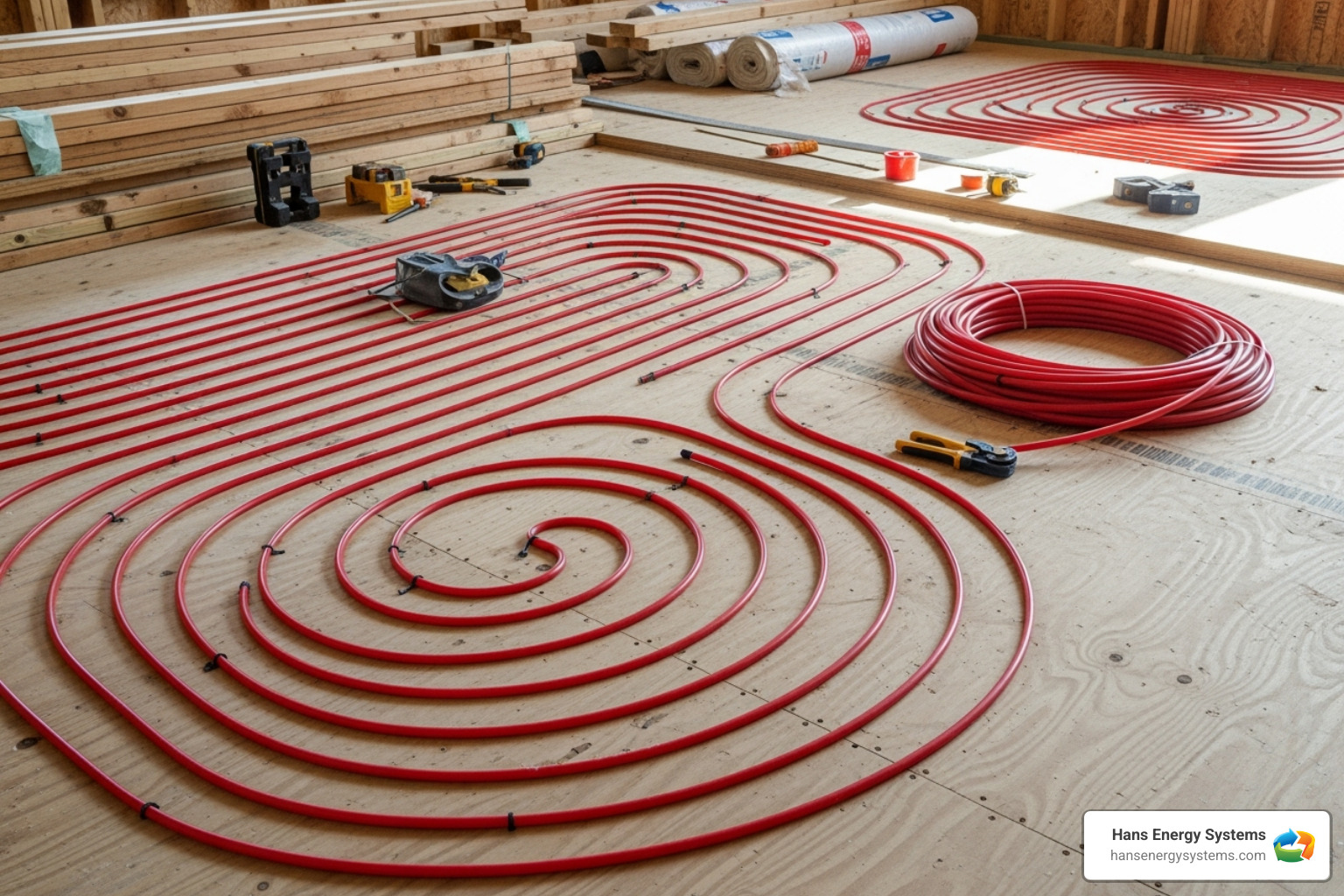
Typical Installation Costs
The cost of radiant heating systems is not one-size-fits-all. The final price is influenced by the system type (hydronic or electric), project size, installation complexity, flooring choice, and local labor rates in San Diego County.
Most contractors price radiant heating by the square foot. However, whole-house systems involve additional components like boilers, manifolds, and control systems that add to the overall investment.
Hydronic systems typically require a larger upfront investment for whole-house installations. But the long-term energy savings often make up for that initial cost, especially in larger homes.
Electric systems can be more budget-friendly for smaller areas like bathrooms. However, scaling them up for whole-house heating can increase costs, and operating expenses might be higher depending on local electricity rates.
Several factors can push costs up or down. New construction installations are generally less expensive than retrofits. The type of flooring you choose matters, and you may need electrical upgrades or a new boiler, which adds to the investment.
For detailed cost information specific to your area, Angi’s cost data provides helpful regional insights. The best approach is getting a personalized estimate from a qualified professional.
Choosing Flooring for Radiant Heating Systems
Choosing the right flooring is a key part of planning your radiant heating systems. Most flooring types are compatible, but some conduct heat better than others.
The secret is understanding how different materials conduct and store heat. Ceramic tile and stone are champions for radiant heating. They are like thermal sponges—they soak up heat quickly and release it slowly and evenly.
Concrete floors are also excellent, particularly with a slab foundation. Embedding hydronic tubing into concrete creates a “thermal battery” that stores massive amounts of heat and radiates it for hours.
Engineered wood performs much better than solid hardwood because its layered construction is more stable with temperature fluctuations.
Laminate and vinyl flooring can work well, but be sure to choose products specifically rated for radiant heating compatibility.
Carpet is the trickiest. It insulates rather than conducts, so if you love carpet, go for lower-pile options with thin padding to let more heat through.
Solid hardwood requires the most care. Wood naturally expands and contracts with temperature changes, which can lead to gaps or warping. If hardwood is your dream, choose narrower boards and work with an experienced installer.
The best approach is always consulting with both your radiant heating installer and flooring manufacturer to ensure your new system delivers maximum comfort and efficiency.
Frequently Asked Questions about Radiant Heating
When considering radiant heating systems, homeowners often have questions. Here are the most common ones we hear from families in San Diego County.
How long does it take for radiant floors to warm up?
It depends on your system type and floor construction. Understanding the differences will help you choose the right option for your lifestyle.
Electric radiant heating systems are the speedsters of the radiant world. You’ll typically feel the warmth within 30 minutes to 2 hours, making them perfect for spaces like bathrooms.
Hydronic radiant heating systems are more gradual, especially in concrete slabs. The concrete acts as a thermal battery, taking 2 to 8 hours to warm up but holding that heat for a very long time.
However, most homeowners with hydronic systems don’t notice the warm-up time after installation. These systems are designed to run continuously at a low temperature, maintaining a perfect comfort level day and night.
The thermal mass of your installation makes a big difference. A concrete slab will take longer to warm up but provides the most stable heat. Dry installations warm up faster but don’t store heat as long.
What is the lifespan and maintenance for radiant systems?
Radiant heating systems are exceptionally durable and built to outlast most other systems in your home.
Hydronic systems are marathon runners. The PEX tubing can last 40 to 50 years or more. The boiler or water heater that feeds the system will need replacement every 15 to 20 years, similar to any major appliance.
Electric radiant heating systems also go the distance, usually providing reliable warmth for 30 to 40 years. With fewer moving parts, they’re often even more trouble-free.
Maintenance is minimal compared to forced-air systems. There are no ducts to clean or filters to change.
For hydronic systems, maintenance is simple. Your boiler needs an annual check-up, and we’ll verify that pumps and pressure levels are running smoothly.
Electric systems are even easier, typically needing little more than ensuring the electrical connections stay secure over the years.
This longevity and low maintenance make radiant heating systems a smart investment. When you’re ready to ensure your system stays in peak condition, our team provides comprehensive HVAC Maintenance services in Poway, CA to keep everything running smoothly.
Are radiant heating systems safe?
Yes, and in many ways, radiant heating systems are safer than traditional heating methods.
A key safety advantage is the low surface temperatures. Your radiant floors typically operate between 80°F and 95°F—warm enough to feel cozy, but never hot enough to cause burns, unlike traditional radiators.
There are no hot surfaces or open flames to worry about. Everything is safely tucked away beneath your flooring, out of sight and out of harm’s way.
For electrical safety with electric systems, modern installations include multiple layers of protection. The heating cables are waterproof and installed with ground fault circuit interrupters (GFCIs) that instantly shut off power if any issues arise. This is why professional installation is so important.
Water leak risks for hydronic systems are extremely rare with today’s durable PEX tubing. Before we cover any system, we perform thorough pressure tests to ensure everything is perfect.
When properly installed by qualified professionals, radiant heating systems provide decades of safe, reliable comfort.
Transform Your Poway Home with Superior Comfort
Radiant heating systems offer more than just warmth; they redefine home comfort. They create an environment with consistent warmth from the ground up, energy efficiency that leads to real savings, and healthier living with cleaner air, free from the dust and allergens circulated by forced-air systems.
Imagine stepping onto warm floors on a chilly morning, enjoying a perfectly silent and consistent temperature, and breathing fresh, clean air. This is the daily reality radiant heating systems provide.
The efficiency benefits lead to tangible comfort improvements and cost savings that compound annually. Feeling comfortable at a thermostat setting 6 to 8 degrees lower than with traditional heating means money back in your pocket and a lighter environmental footprint.
At Hans Energy Systems, we’ve been helping homeowners throughout San Diego County find the transformative power of superior heating solutions. Our team understands the unique climate challenges of Southern California. We bring exceptional customer service, competitive pricing, and reliable, professional work to every project, whether you’re building new or upgrading your existing home.
The investment in radiant comfort pays daily dividends: the luxury of warm floors, silent operation, lower energy bills, and the confidence of a long-lasting system. It’s not just about heating; it’s about elevating your entire home experience.
Ready to step into the future of home comfort? Our experts are here to help you explore how radiant heating systems can work in your specific situation. We’ll walk you through the options, answer all your questions, and ensure you get the perfect system for your needs and budget.
Contact us for HVAC services in Poway, CA and find what true comfort feels like. Your feet – and your family – will thank you.


